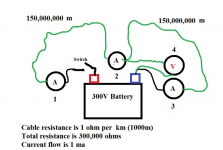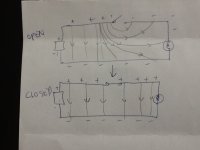A great question Bill and one that reminds me of a question I posted in the BT thread many many years ago. This is a copy of the question.
Simons puzzle reminded me of my days at college. At the instant the switch is closed the lecturer would say...... now calculate the current in L and this that and the other... and so on.
What do you guys think would be the outcome of this. Maybe its a silly question, maybe not. I'd be interested to hear your thoughts even if my maths won't keep up 😀
The green wire is 300,000km in length. If we say (for arguments sake) that the "speed" of electricity in a copper wire conductor approaches the speed of light, then, by conventional thinking it would take one second for electricity to travel down the wire. In the diagram, the four meters are all near the observer who is located by the battery and switch. The 300,000km of wire goes its merry way looping back to the observer at the midpoint. Under steady state conditions a current of 1ma flows. Each ammeter would show 1ma with the voltmeter at midpoint showing 150 volts.
So... on closing the switch, what would each meter read. Say you took 10 readings each spaced 100ms apart. What would you see ?
Attachments
Maybe the observer has very long arms and can throw the switch from his position near the lamp 😎
How long does it take for him to stretch out his arm from his position near the lamp to reach the switch?
Hypothetical, of course .
Jan
I assumed the switch, lamp and psu would be at 3 equally spaced locations at the very outskirts of the universe "orb", because they should be as far apart as possible, and the location of measurement would be at the center. This would however, demand that one used a relay in place of a switch, so you could calculate the delay from pressing the switch (which would be at measuring position) until the relay is activated, and then you could subtract that from the time of triggering the relay, until the light reaches the location of measurement.
!?
And ofcourse the universe is expanding, so how much will the circuit increase from activating the switch until the measurement position has light?
I think there is room for one of my favourite quotes:
“The bureaucracy is expanding to meet the needs of the expanding bureaucracy.”
― Oscar Wilde
Edit:
Imagine a simple circuit. Just a lamp a power supply and a switch connected so that when you throw the switch, the light goes on.
Question: Now imagine this circuit to have the size of the visible universe, with all the 3 components as far away as possible. If you throw the switch when does the light go on?
And it's not explicitly specified, but if following this task to the letter, one can interpret that the circuit must take up the volume of the known universe. Packing cable as dense as possible to make the circuit as large as possible would make the signal take a close to infinite amount of time from activation until measurement. And thickness of cable is not specified, it would greatly influence the resistance and lenght of the circuit.
Last edited:
Maybe the observer has very long arms and can throw the switch from his position near the lamp 😎
How long does it take for him to stretch out his arm from his position near the lamp to reach the switch?
Hypothetical, of course .
Jan
That adds at least another extra some 85 billion years unless some fatique will hinder the activity during stretching.
Resistance would be zero at absolute zeroAnd thickness of cable is not specified, it would greatly influence the resistance and lenght of the circuit.
Edit, I could be wrong 😉
Last edited:
A great question Bill and one that reminds me of a question I posted in the BT thread many many years ago. This is a copy of the question.
... did a "correct" answer ever emerge? 🙂
Yes, > than 85 Million years.
Up to twice as much depending of details.
Which is accurate enough compared to the "instant" or "very short time" implied in answer #4
Up to twice as much depending of details.
Which is accurate enough compared to the "instant" or "very short time" implied in answer #4
Resistance would be zero at absolute zero
Edit, I could be wrong 😉
Resistance would be *lower* at the very least. Did not even cross my mind to consider temperature.
I was more concerned with how much power the lightbulb would consume so that it would be detectable in the center, a bit simplified: voltage drop is more or less the same over distance in a specific cable, so higher voltage gives less overall loss of power if cable thickness is a limiting factor. But you'd probably need some power to make the light source give off enough light, so to support enough current without incurring additional losses you would inevitably have to consider the cable thickness.
Given the wording of the "assignment", pending on how you decide to interpret it, the task might be unsolveable unless you really start diving into deeper physics.
Is it about making a circuit as big as the universe or is it about making the circuit in this very universe?
A universe where only the circuit exists, would need far less light to be detectable.
Sorry!
Math is not my strongest suite, so I focus more on other aspects.
Member
Joined 2009
Paid Member
Maybe the observer has very long arms and can throw the switch from his position near the lamp 😎
How long does it take for him to stretch out his arm from his position near the lamp to reach the switch?
Hypothetical, of course .
Jan
even worse, since the fingers at the end of these arms are actuated by muscles in the arms which can move no faster than the speed of sound if there are to be no shock waves
... did a "correct" answer ever emerge? 🙂
If that's "yes" to me, I meant Mooly's question.....
🙂 I'm not really sure tbh. It all seemed a bit open to interpretation to me.
I wondered if the voltmeter in the middle of the wire would read 300 volts after say 0.5 seconds and then 150 volts after 1 second.
What would the ammeters show... maybe zero current (apart from V4 meter current) until 1 second when all three would then show 1 milliamp.
But the electrical potential is everywhere in the circuit, so as soon as the switch is closed the light goes on. The information doesn't need to travel the galaxy, it's already there.
Yes the electric potential ( field ) is there but it has to change when the switch is flipped. This change takes time.
Attachments
Maybe the observer has very long arms and can throw the switch from his position near the lamp 😎
How long does it take for him to stretch out his arm from his position near the lamp to reach the switch?
Hypothetical, of course .
Jan
The limit on that, assuming physical movement of material, will be the speed of sound in the substance of the observer's 'arms.' Compared with the electronic transmission line effect, it'd be like watching a large slowly unfurl a tentacle...
You've just made the experiment take 200,000-1,000,000 longer: so it is likely the current universe ends before outcome is observable %)
PS unless the observer has conveniently folded space-time in ways we cannot at present, and to them it's just like poking the switch on the other side of a rubbery membrane between 'here' and 'there' . And if your observer has access to that kind of physics, the whole thing is moot anyway!
Last edited:
That's 85 *BILLION* years [emoji6]Yes, > than 85 Million years.
Up to twice as much depending of details.
Which is accurate enough compared to the "instant" or "very short time" implied in answer #4
Sorry, an un-corrected typo 🙁
But in any case we are comparing **huge** time vs "instant" and that´s the main point.
As a side note, I would not add muscles, sound speed and other extra variables which are not in the original riddle.
Let´s not lose focus on what anyway is a rethoric question.
Same as considerations on wire resistance, inductance, capacitance, all those parameters must be engulfed inside the signal transmission speed concept, which IS relevant to original question, no need to further disperse into secondary questions on penalty of discussing cloth covered vs. Teflon wire in a couple weeks.
But in any case we are comparing **huge** time vs "instant" and that´s the main point.
As a side note, I would not add muscles, sound speed and other extra variables which are not in the original riddle.
Let´s not lose focus on what anyway is a rethoric question.
Same as considerations on wire resistance, inductance, capacitance, all those parameters must be engulfed inside the signal transmission speed concept, which IS relevant to original question, no need to further disperse into secondary questions on penalty of discussing cloth covered vs. Teflon wire in a couple weeks.
This thread reminds me of the XKCD "what if" series. A good read if you're into deep mathematical analysis of various scenarios.
Earth-Moon Fire Pole
Earth-Moon Fire Pole
That's 85 *BILLION* years [emoji6]
Isn't that a little on the "hevy side"? 😉
//
It's conservative if anything. The visible universe is a sphere with diameter of approx. 93 Billion light years [emoji2962] 100 Million years is barely a blip.Isn't that a little on the "hevy side"? 😉
//
Since the observer must be stationed at the switch and the switch is positioned as far as possible from the light then the observer will only be able to confirm that the light is on after the light from the bulb has travelled across the universe to the observer located at the switch - hence the calculations above are under estimating the time taken as measured by the observer
Einstein wrote about that in 1905, chapter 1 section 1 of this article:
Zur Elektrodynamik bewegter Körper
Zur Elektrodynamik bewegter Körper - pdf
When you have two experimenters, one at the switch and one at the lamp, both having a clock and a flashlight, they can check whether their clocks are properly synchronized by measuring the time light needs to travel from A to B and from B to A. When there is any difference, the clocks need to be adjusted. Once you have two observers with synchronized clocks, they can just do the experiment. It's a pity that this simple calibration will take at least another 170E9 years, though.
Last edited:
- Home
- Member Areas
- The Lounge
- Electrical circuit the size of the visible universe.


